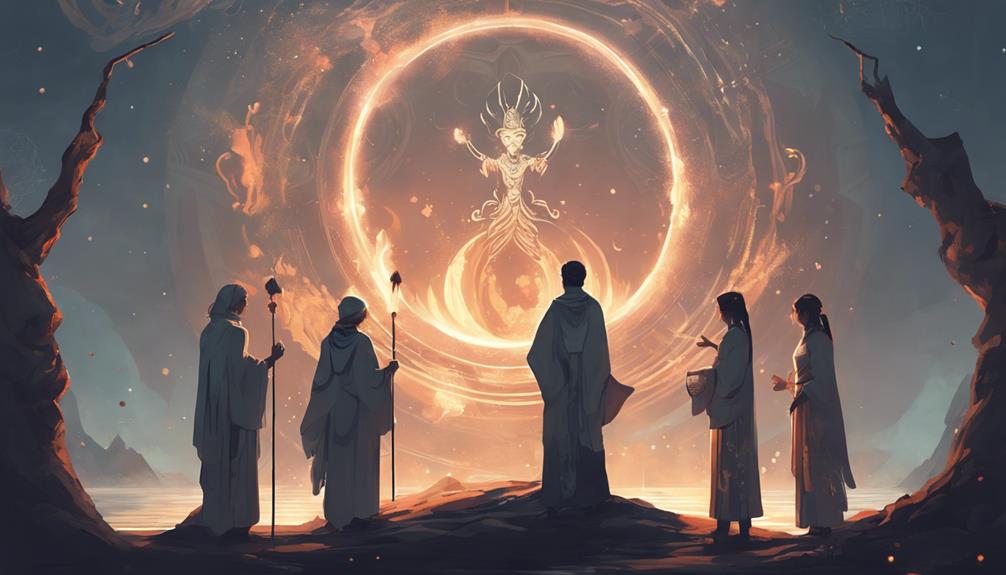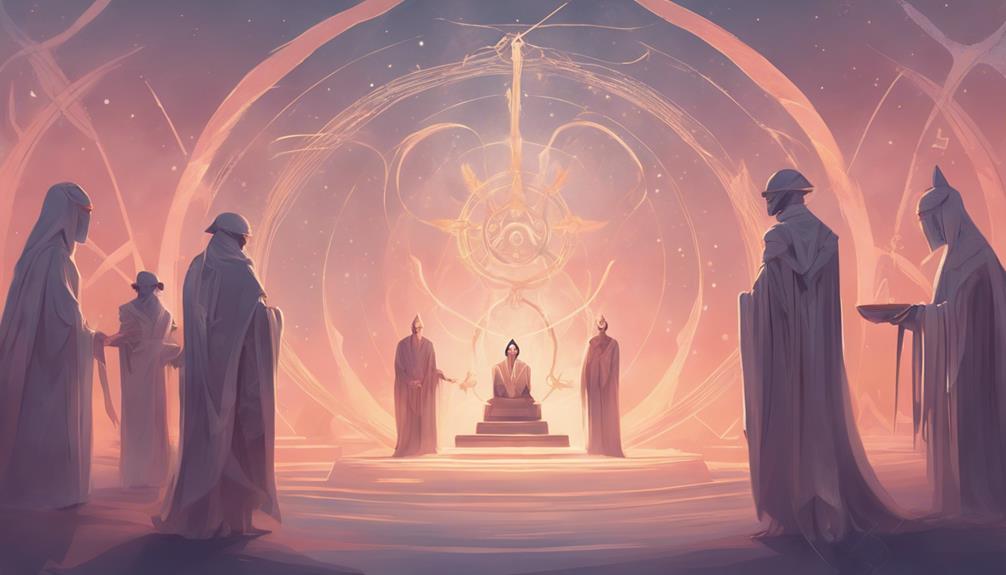Summary
- 1 Ancient ceremonies
- 2 Modern practices
- 3 Birth rites
- 4 Marriage traditions
- 5 Funeral rites
- 6 Seasonal celebrations
- 7 Rites of initiation
- 8 Healing Rites
- 9 Pilgrimages and travel
- 10 Frequently asked questions
- 10.1 How do sacred rituals affect community bonding and social cohesion?
- 10.2 What is the role of sacred rituals in personal spiritual growth?
- 10.3 How have global migrations affected the practice of sacred rituals?
- 10.4 Are there universal elements present in the sacred rituals of different cultures?
- 10.5 How do sacred rituals adapt to technological advances and modern lifestyles?
Investigating the sacred rituals offers a glimpse into the practices that connect communities to their spiritual and cultural roots. From birth rituals that welcome newborns to the marriage traditions symbolizing unity, these ceremonies shape identities. Funeral rites offer comfort about the afterlife, while the seasonal celebrations as Diwali and Yule mark important times of the year. The modern practices include digital worship and hybrid ceremonies that mix the old with the new. Healing rituals, such as Ayurveda and sound baths, promote well-being and inner peace. Pilgrimages such as the Hajj offer transformative journeys. There is much more to discover about these rich and meaningful traditions.
Ancient ceremonies

Through the mists of time, ancient ceremonies have shaped cultures and connected people to their beliefs in profound ways. Imagine standing in a circle of flickering flashlights, participating in a ritual thousands of years old. These ceremonies often involved offerings to deities, dances and chants aimed at communicating with the divine or honoring ancestors.
Take, for example, the rituals of ancient Egypt dedicated to deities such as Ra and Osiris. Priests performed intricate ceremonies in temples, using sacred instruments and reciting prayers to ensure harmony between the gods and the people. You can imagine the solemnity and sense of connection the participants felt.
In another part of the world, Native American tribes celebrated ceremonies such as the Sun Dance to seek visions and blessings. Participants fasted, danced and sometimes endured physical trials to demonstrate their dedication and achieve spiritual growth. These rituals were not just tradition; they were a way to connect deeply with nature and the spirit world.
Understanding these ancient ceremonies helps you appreciate how they shaped societies, offering a glimpse into the spiritual lives of our ancestors. They were not just events; they were lifelines with the divine.
Modern practices
In today's world, you can participate in a worship service from your living room thanks to the digital worship trends. Le hybrid ceremonies combine traditional practices with modern technology, enabling both in-person and virtual participation. These innovations make it easier than ever to stay connected to your spiritual community.
Digital worship trends
As technology transforms our daily lives, trends in the digital worship Are redefining the way people practice their faith. You may find yourself joining a prayer group on Zoom or to stream a Sunday service from your living room. These digital avenues make it easier to stay connected to your faith community, even when you can't physically be there.
Think about the apps that send you daily scripture readings o meditation suggestions. These tools help you integrate spiritual practices into your busy schedule. Instead of reserving specific moments, you can devote time for reflection when it is most convenient for you.
Social media also plays an important role. You might follow religious leaders on platforms such as Instagram and Twitter, where they share inspirational messages, live sermons, and community updates. This creates a sense of belonging, even if you are miles away from your fellow believers.
In addition, virtual reality (VR) is entering the scene, offering immersive experiences as virtual pilgrimages Or visits to temples. Imagine "visiting" sacred places from the comfort of your own home.
Digital worship trends offer flexibility and accessibility, allowing you to maintain your spiritual practices in a modern, connected world.
Innovations in Hybrid Ceremony
Building on the rise of digital worship, hybrid ceremony innovations are blending traditional rituals with modern technologies to create unique spiritual experiences. These hybrid ceremonies appeal to everyone, offering the comfort of home and the rich traditions of faith communities. They use technology to bridge the gap between physical and virtual spaces.
Here are four ways in which hybrid ceremonies are implemented:
- Live Streaming Services: You can attend a church service from anywhere in the world. This makes it easy for those who cannot travel or prefer to stay at home to actively participate.
- Virtual Prayer Circles: These online meetings allow you to connect with others in real time, share prayers and offer support, even if you are miles away.
- Interactive Ritual Kits: Sent to participants' homes, these kits include items such as candles, prayer beads, and sacred texts. You can follow the ceremony, making it a tactile experience despite the distance.
- Augmented Reality (AR) Experiences.: AR apps can bring sacred spaces to life in your living room. Imagine viewing a 3D model of a temple or church and really feeling like you are there.
These innovations ensure that spiritual practices remain inclusive, relevant and deeply personal.
Birth rites

Welcoming a new life into the world, many cultures celebrate birth with unique and deeply meaningful rituals. These traditions reflect the values and beliefs of a community, offering blessings and protection to the newborn.
Take a look at some birth rituals from different cultures:
| Culture | Ritual | Meaning |
|---|---|---|
| Hindu | Jatakarma | Welcomes the baby with honey and ghee |
| Jewish | Brit Milah | Circumcision on the eighth day |
| Navajo | First Smile Ceremony | Celebrate baby's first smile |
In Hindu culture, the Jatakarma ritual involves touching the baby's lips with honey and ghee, symbolizing purity and sweetness. It is a way to welcome the child into the world with love and blessings.
For Jewish families, Brit Milah is a significant ceremony in which male children are circumcised on the eighth day after birth. This ritual symbolizes a covenant with God and is a deeply spiritual event.
The Navajo people celebrate the baby's first smile with a special ceremony. They believe that the first smile shows that the child's spirit is fully united with the community. This joyous event includes a banquet and gifts, ensuring that the baby feels loved and protected.
These birth rituals, though varied, all share the common goal of integrating the newborn into one's community and showering love and blessings on him or her.
Marriage traditions
Marriage traditions around the world are rich weavings of customs and ceremonies, each reflecting the unique cultural heritage and values of a community. These rituals not only unite two individuals but also bind families and sometimes entire communities together. Let's take a look at some fascinating examples:
- Indian Weddings: In India, weddings are large events that last several days, filled with colorful dresses, intricate henna designs and the sacred fire ritual where the couple circles the fire seven times, symbolizing their vows.
- Japanese Shinto Weddings: These ceremonies often take place at shrines, where the couple participates in a purification ritual and sips sake from three cups, symbolizing unity.
- Greek Orthodox Weddings: Here, coronets are placed on the heads of the bride and groom, symbolizing their roles as king and queen of their small kingdom, their home. The coronation is followed by a ceremonial walk around the altar.
- Mexican Weddings La Vibora de la Mar: During this playful tradition, the bride and groom hold hands and form an arch while guests dance and zigzag under it, representing the couple's challenges and how they will face them together.
Understanding these traditions helps you appreciate the profound spiritual meanings and cultural backgrounds behind wedding ceremonies around the world.
Funeral rites

Funeral rites in all cultures reveal deep beliefs about life, the afterlife and the journey of the soul. In many traditions, these rites help the living cope with loss and ensure a smooth transition of the deceased to the next world. For example, in ancient Egypt, elaborate mummification and tomb preparation were believed to protect the body and spirit for eternity. You might find it fascinating how these practices reflect a strong belief in an afterlife where the soul would need its earthly body.
In contrast, Hindu funeral rites involve cremation. The body is returned to the elements, symbolizing the release of the soul and its journey to reincarnation. Families often scatter the ashes in sacred rivers such as the Ganges, believing that it purifies the soul and promotes its passage.
In Mexican culture, Día de los Muertos, or Day of the Dead, celebrates those who have passed on. Families create altars with photos, favorite foods and souvenirs, inviting the spirits to visit and enjoy earthly pleasures once again. This tradition shows a deep connection and ongoing relationship between the living and the dead.
Funeral rites, though varied, universally express deep respect and care for the souls of the departed, reflecting each culture's unique view of the life cycle.
Seasonal celebrations
Seasonal celebrations around the world highlight the diversity of human culture, marking nature's changes with joyful rituals and traditions. These gatherings unite communities, celebrating Earth's rhythms in unique and colorful ways. Here are four examples of such celebrations:
- Diwali (India): Known as the Festival of Lights, Diwali celebrates the victory of light over darkness. Families light oil lamps and fireworks, share sweets and decorate their homes with rangoli.
- Hanami (Japan): During spring, cherry blossoms bloom and people gather under the trees for picnics. This tradition, known as Hanami, is a time to appreciate the fleeting beauty of nature.
- Oktoberfest (Germany): This famous fall festival in Munich is a celebration of Bavarian culture. It involves lively music, traditional clothing and, of course, lots of beer.
- Yule (Scandinavia): Celebrated during the winter solstice, Yule involves lighting candles and fires to symbolize the return of the sun. It is a time to celebrate and honor ancient traditions.
These seasonal celebrations not only mark the passage of time, but also strengthen community ties and create lasting memories. By participating, you can experience the deep connection between nature and human culture.
Rites of initiation

Initiation rites mark significant transitions in life, guiding individuals through important cultural milestones with rituals that often symbolize growth and transformation. These ceremonies can range from celebrations of passage into adulthood to entering a community or assuming new roles. For example, in many indigenous cultures, young people face rites of passage that mark their transition from childhood to adulthood. These might include physical challenges, spiritual teachings or community ceremonies.
In some religious traditions, baptism serves as an initiation rite, welcoming individuals into the faith. The act of being immersed in water or sprinkled with water symbolizes purification and a new beginning. Similarly, in academic circles, graduation ceremonies act as initiation rites, marking the transition from student to graduate. One wears special robes, receives a diploma, and often participates in centuries-old traditions that highlight one's achievements and next steps in life.
Understanding initiation rites helps you appreciate how different cultures and communities emphasize the importance of growth and change. These rituals provide a sense of belonging and identity, making life changes meaningful and memorable. Whether simple or elaborate, initiation rites connect individuals to their heritage, community, and personal development.
Healing Rites
Healing rituals have been part of human culture for centuries, whether using ancient herbs or chanting in sacred spaces. Today, many of these practices are adapted in modern contexts, such as yoga or meditation classes. You will also find community ceremonies that bring people together to support mutual healing paths.
Ancient healing practices
Throughout history, various cultures have relied on ancient rituals to heal both body and spirit. These practices often involve a mixture of natural elements, spiritual beliefs and communal activities. They are fascinating because they show how connected our ancestors were to both the environment and their inner selves.
Here are some fascinating ancient healing practices:
- Ayurveda: Originating in India over 3,000 years ago, Ayurveda combines diet, herbal treatments and yogic breathing to balance the body's energies.
- Shamanic healing: Shamans, found in indigenous cultures around the world, enter altered states of consciousness to communicate with the spirit world, seeking guidance and healing for their communities.
- Traditional Chinese Medicine (TCM): This practice includes acupuncture, herbal medicine and tai chi, aiming to restore harmony between the energies yin and yang Of the body.
- Sweat Lodge ceremonies: Used by Native American tribes, these ceremonies involve intense heat and steam to purify the body and mind, often accompanied by chants and prayers.
Each of these practices offers a unique window into how our ancestors understood health and wellness. They remind us that healing is not only a physical process but also a spiritual journey.
Adaptations of modern rituals
In today's fast-paced world, many people are resorting to modern adaptations by ancient healing rituals to find balance and peace. These rituals could include elements such as meditation, the healing with crystals, or even the sonic baths. You may feel attracted to a yoga class which incorporates chanting and meditation, helping you relax and center yourself.
One popular adaptation is the use of crystals. People believe that the different types of crystals emit unique energies that can promote physical and emotional healing. For example, you could use amethyst to calm the mind or rose quartz to attract love and compassion. Simply carrying these stones with you or placing them around your living space can make a difference.
Another example is the sound healing, which uses the vibrations of singing bowls, gongs or tuning forks to restore your body's natural frequencies. You could participate in a sound bath session where you lie down and let the soothing sounds wash over you, helping to reduce stress and anxiety.
These modern adaptations are easy to integrate into your daily life. By incorporating these practices, you can create a personal sanctuary offering comfort and healing amidst the chaos of modern life.
Community Healing Ceremonies
Many communities around the world gather in healing gatherings to foster a sense of unity and collective well-being. These rituals are not just about physical health; they also focus on emotional and spiritual healing. By participating in these gatherings, you can experience a deep sense of connection and support from others.
Imagine being part of a healing gathering; it might include:
- Drum Circles: The rhythmic beat of the drums can create a powerful, almost hypnotic state, helping you release stress and reconnect with your inner self.
- Purification Rituals: Burning herbs such as sage can purify the space and your spirit, promoting a feeling of peace and clarity.
- Singing and Singing: Collective voices lift your spirit, allowing you to feel part of something bigger than yourself.
- Healing Touch: Simple gestures such as holding hands or light touches can convey positive energy, making you feel supported and loved.
These gatherings are often rooted in ancient traditions but can be adapted to meet modern needs. They are a tribute to the resilience of the human spirit and the power of community. By participating in these rituals, you are not only healing yourself but also contributing to the well-being of those around you.
Pilgrimages and travel

A pilgrimage is not just a journey; it is a profound journey that transforms both body and soul. When you set out on a pilgrimage, you are not simply traveling from one place to another. Instead, you are embarking on a spiritual search which can lead to significant personal growth. Think of the millions of people who travel the Pilgrim's Way to Santiago in Spain. They don't just do it for the exercise or the scenery; they seek a sense of purpose, healing or spiritual awakening.
You might also consider theHajj, the Islamic pilgrimage to Mecca. For Muslims, this journey is one of the Five Pillars of Islam and should be done at least once in a lifetime, if possible. It is a time of reflection, prayer and community, uniting millions of people from various backgrounds in a shared spiritual experience.
Even if you are not religious, you can still find value in a pilgrimage. For example, retracing the steps of a favorite author or visiting historical sites can offer a similar feeling of connection and insight. Ultimately, pilgrimages and travel invite you out of your daily routine, offering you the opportunity to rediscover yourself And your place in the world.
Frequently asked questions
Sacred rituals unite people, creating shared experiences and memories. When you light candles or sing hymns with others, you feel connected, fostering a sense of belonging and strengthening community ties and social cohesion.
What is the role of sacred rituals in personal spiritual growth?
Sacred rituals help you connect with your inner self, offering moments of reflection and peace. By participating, you will find personal growth, deeper understanding and a stronger sense of purpose in your spiritual journey.
How have global migrations affected the practice of sacred rituals?
Global migrations have led you to mix sacred rituals, creating new traditions. You might celebrate a festival from your homeland by incorporating elements of your new culture, enriching your spiritual practice and encouraging a shared community experience.
Are there universal elements present in the sacred rituals of different cultures?
You may notice that many sacred rituals share universal elements, such as music, dance and symbolic objects. These elements help connect participants to something greater, creating a sense of community and shared spiritual experience, regardless of culture.
How do sacred rituals adapt to technological advances and modern lifestyles?
You will find that sacred rituals adapt by incorporating technologies such as live streaming for remote participation and apps for prayer reminders. The modern lifestyle means they are more flexible, adapting to busy schedules without losing their spiritual essence.
